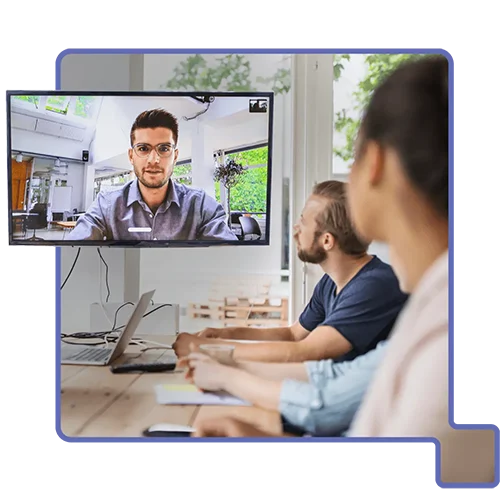Here are seven ways you can reshape culture and leadership for a sustainable hybrid workplace and meet the expectations of your employees and future talent pool.
Prioritise flexible work practices for your hybrid workforce
The pandemic allowed us to reinvent our workplace—and in a hybrid workplace, prioritising flexible work practices is a cultural imperative. To make it work, leadership needs to:
Autonomy and trust are essential to motivate a hybrid workforce to maximise productivity. In practice, this can mean a commitment to mobile-friendly applications—more than just your email and calendar—but customising key business apps to be mobile-friendly.
Invest in modern tools and infrastructure to empower employees
Optimising your hybrid workplace requires investments to support virtual collaboration for scheduling and safety. Employees have adapted to remote technologies, and they expect employers to do the same and lead the charge toward user-centric technology. Don’t assume the technician that worked on-site is up to the job for remote work—your people may need different hardware, apps, and technology policies to be successful.
Think about their technology needs beyond a phone and a laptop. If employees attend virtual meetings, is their internet connection secure and up to the task? How is their camera? Do they have good sound quality? Virtual communication won’t always be perfect, but it’s a business imperative to give your employees the tools they need: 84% of employees are looking for better digital tools. (EY, 2021)
Nurture a new mindset in your IT leaders
There’s an age-old battle between what IT decides and what frustrated users need. Understandably, your employees may need to work within mandated software and apps for the key requirements—but don’t let policy be so stringent that new tools are disregarded. Ask your staff what’s working for them. If they’re using something new, be prepared to listen and learn to understand the gap in capability they are trying to fill.
Forcing your IT department to dictate, use, and enforce outdated policies creates a divide among employees. Reposition your IT team as a service centre with customers—your employees. If you’re not sure what technology could assist your employees as they work from their home office, the kitchen bench, or a café—ask them. Creating an employee feedback loop that has some tangible impact will help them feel heard and stay on track.
Provide mobility without compromising data security
As the line blurs between work and life, offering employees a choice of bringing their own communication device or going all-in with company hardware configured to allow for personal use, proves flexibility and trust—but the trick is to do it without compromising data security. The main concern about hybrid or remote work is the increased cybersecurity risks in allowing employees to access internet connections across multiple networks and devices—anytime, anywhere.
To address this concern, get your IT team to provide security and software training for employees to protect their devices and information. This may mean having some tough conversations with your IT team—but endpoint security is not to be taken lightly. Show them that increased security across home devices is a positive change.
Focus on health and safety, especially mental health
Research shows that employees rank health and safety as a top-five concern—and 86% of employers are already planning on enhancing workplace safety1. Whatever business you’re in, health and safety policies and processes that protect your employees and your clients are non-negotiable. It goes beyond a safe, clean, and healthy workplace—regardless of where your employees work from, their health and safety are still your responsibility.
We’ve touched on hygiene and health, but there is a silent issue that has the potential to devastate the workforce—mental health. The two main struggles associated with remote work are not being able to unplug from work and feelings of loneliness. Mental health support may look different for each individual.
For some, it’s having the flexibility to care for children or elderly family members; for others it’s about having access to an employee assistance program that offers free, confidential counselling and support. If your business can step up as a support for the whole person rather than monitor them via productivity or absenteeism—you are one step closer to ensuring their wellbeing and their loyalty.
Bridge the gap between physical and digital experiences
In hybrid work, it’s inevitable that someone will be remote, despite how well teams coordinate their in-office days. It can get frustrating for remote colleagues who are unable to participate equally and tend to become less engaged—especially for creative people who often use collaboration tools such as whiteboards and displays. Address how to boost engagement and make your remote employees feel inclusive.
One way to bridge the gap is to integrate physical spaces with user-friendly technology, like being able to connect to a meeting on individual devices as well as the technology in the room. For a more seamless and inclusive hybrid collaboration experience, provide solutions that allow people to be seen and heard in the meeting room, with the right tools like in-room microphones, speakers, easy-to-move markerboards, and displays for various room sizes in the office. This enables you to keep the focus on the people and the user experience while technology works seamlessly in the background.
Shift your thinking on training and skills development
Upskilling and career development can’t take a backseat forever to managing change and staying productive from anywhere.
Shake off the idea that upskilling employees is preparing them for a new job somewhere else—you can’t retain every employee in this competitive environment, and you shouldn’t want to. Focus on making daily work life easier, and you’ll keep the best of the bunch.

Let us help you power up your hybrid workplace.

Let’s connect
Get in touch with one of our consultants and find out how we can help you create your hybrid workplace.
Recommended resources for you

How to Build Collaborative Work Environments for Hybrid Workforces
Unlock the full potential of your workforce. Learn how collaborative solutions can enhance communication, boost productivity, and foster innovation across dispersed teams.

How to Secure Your Digital Workplace from Cyberattacks
Learn how to protect your digital workplace from cyberattacks, safeguarding your data, reputation, and business.

How to Create a Hybrid Workplace That Works
Uncover strategies to build an inclusive hybrid workplace that boosts productivity and engagement.


